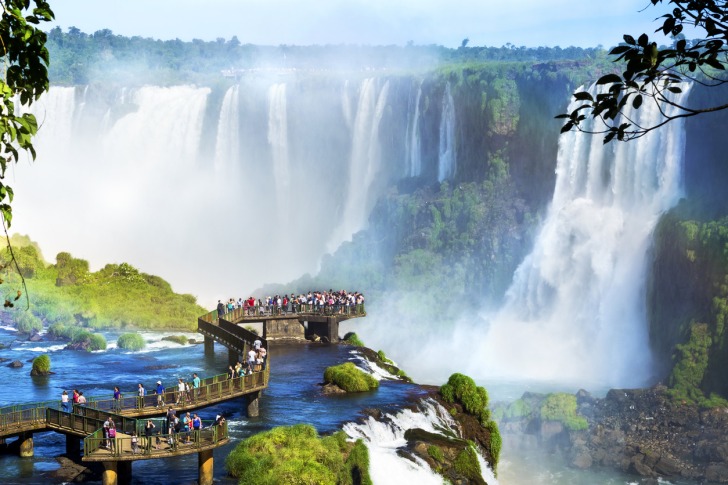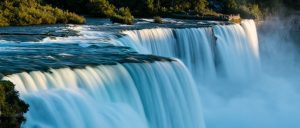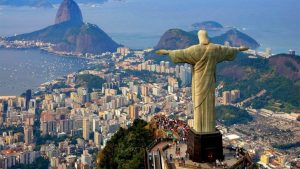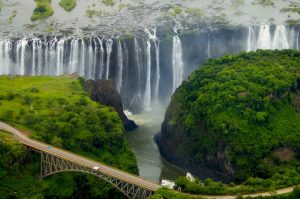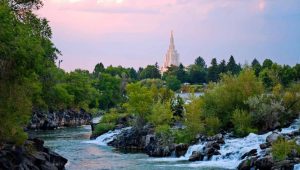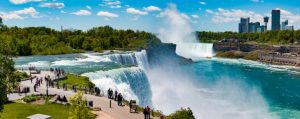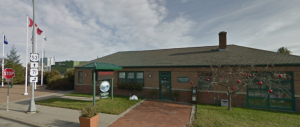 Argentina : Safety by City
Argentina : Safety by City
- Buenos Aires
- Cordoba
- La Plata
- Mendoza
- Neuquen
- Puerto Iguazu
- Puerto Madryn
- Rosario
- Salta
- San Miguel de Tucuman
- Ushuaia
In 2011, Iguazu Falls was chosen to be on the list of one of the New 7 Wonders of Nature due to its incredible beauty and mystical atmosphere.
As a result, this natural wonder has become one of South America’s most visited destinations; Iguazu Falls on the Iguazu River forms the border between Brazil and Argentina.
The closest town to the falls is Puerto Iguazu, a city of around 82,000. North of Puerto Iguazu, across the border, is Foz do Iguacu, Brazil, and west is Ciudad del Este, Paraguay.
These are the main lodging areas for those visiting Iguazu Falls, with Puerto Iguazu only around 17 miles away.
Suppose you’re interested in visiting Iguazu Falls and want to stay in Puerto Iguazu.
In that case, it’s essential to understand the potential danger, safest places, areas to avoid, safety tips, and other helpful information before reaching this destination.
Keep reading to learn more!
Warnings & Dangers in Puerto Iguazu

OVERALL RISK: LOW
Due to the increased tourism and resulting police presence, Iguazu Falls is a safe place to visit, even as a solo female traveler. Although standard precautions should be taken, like when visiting anywhere new, visitors shouldn’t be constantly worried about muggings, being scammed, terrorism, or other situations that could occur in major cities.

TRANSPORT & TAXIS RISK: LOW
Puerto Iguazu public transport and taxis are safe and dependable. Tourists regularly take buses due to the efficiency and financial and economic aspects of reaching main attractions. It’s important to note that overcrowding could be a problem during peak tourist months. As with any location, always pay extra attention to your belongings in crowded mass transit. Taxis are metered and a readily available alternative to mass transit, although they will be more expensive.

PICKPOCKETS RISK: LOW
Bag snatching and pickpocketing are considerably lower risks in Puerto Iguazu compared to larger Argentinean cities. However, never drop your guard and remain vigilant, especially in crowded, touristic areas. Also, maintain awareness of your surroundings and secure all belongings to minimize risk.

NATURAL DISASTERS RISK: MEDIUM
Given that the Falls are in the jungle, the area experiences significant rainfall throughout the year, with the most falling in April, May, October, and November. This can cause river flooding, making driving and walking unsafe due to the outdated drainage system. Also, the rain can make for treacherous conditions when hiking to the waterfall and other areas, increasing the mudslide risk. Also, sometimes the mosquito situation, which carries disease, is classified as extreme, so it’s critical to bring the proper gear and bug spray.

MUGGING RISK: LOW
The mugging risk is lower, even when walking alone at night. Typical precautions like avoiding abandoned areas, not displaying expensive items, and being aware of your surroundings apply. Although Puerto Iguazu is a small city with only a few neighborhoods, those near tourist attractions are the most secure.

TERRORISM RISK: LOW
Argentina is stable without the risk of guerrilla fighters living in the jungle. Since Puerto Iguazu is a small city, it is never a place to worry about terrorist attacks. As with any destination, if you see strange behavior, consistently report it to the authorities immediately.

SCAMS RISK: LOW
The risk of being part of a scam in Puerto Iguazu is low. The only real scam in the area is buying photos at Iguazu Falls for an inflated price, like at any major tourist site, but you can politely decline. Regardless of the risk level, take normal precautions and be wary if a stranger attempts to distract you, as you never know who could be attempting to pick your pockets.

WOMEN TRAVELERS RISK: LOW
Puerto Iguazu is a safe destination for female solo travelers. Locals are helpful and friendly, and violent crime is low. Following basic precautions like not carrying large sums of cash or wearing flashy jewelry publicly is essential. Also, be alert at night in the more secluded areas of town, which present a higher risk of petty theft. The main tourist areas, like near the waterfalls, are incredibly safe due to excellent policing.

TAP WATER RISK: LOW
Puerto Iguazu’s tap water is considered safe for locals, but it could cause minor stomach discomfort for visitors unfamiliar with certain microorganisms prevalent in the jungle. Those with a sensitive stomach should drink bottled water, especially in the areas outside the town and after storms where water becomes contaminated.
Safest Places to Visit in Puerto Iguazu
Puerto Iguazu is an entirely safe destination, even at night, so feel free to roam around the city while taking the proper precautions.
Hotels, restaurants, bars, and tourist sites are well-maintained, policed, and regulated, so you don’t need to be overly concerned with crime.
Places to Avoid in Puerto Iguazu
Although you should use standard precautions if wandering into a poorly lit, secluded area, going into the jungle at night is the place to avoid.
It becomes incredibly dark and difficult to navigate with ground hazards plentiful, and getting lost is easy.
Also, predators tend to feed at night, so you don’t’ want to be their next meal!
Safety Tips for Traveling to Puerto Iguazu
- Avoid Restricted Areas. Areas that are roped off or have warning signs are indicators that you should stay away. Don’t hop the rope to attempt to get a photo since you can be seriously injured or worse. Nature is unforgiving, rocks are slippery, and cliffs are dangerous, so if the local authorities warn you to stay out of an area, listen! Also, if you ignore the signs and venture into these areas, you could be fined for trespassing.
- Don’t Accept Drinks from Strangers. If you’re hitting the local nightlife in and around Puerto Iguazu, never accept drinks from strangers you didn’t watch the bartender make. Although drugging is not a major issue here, it doesn’t mean it can’t happen to unsuspecting visitors. The best response to a drink is politely declining, which will lower your risk of an incident.
- Don’t Hike at Night. While this should be obvious, never venture into the jungle alone or at night. Plenty of individuals camp in the jungle, but it’s important not to venture from the campsite. Due to the tree canopy blocking the sky, sections of the wilderness can become incredibly dark, so you can’t see various ground hazards. Also, plenty of hungry predators come out at night, so stick to your campsite or hotel and enjoy nature in the daylight.
- Drink Bottled Water. Although the water is safe to drink in town, those with sensitive stomachs may have an issue, so it’s important to drink bottled water. Also, when venturing to the falls or other areas for the day, bring more water than you could ever drink. The rainforest is hot and humid, so your body will be sweating profusely. Avoid a trip to the hospital for dehydration by just bringing plenty of water for the day.
- Keep Children Close. Walkways and paths are busy, slippery, and narrow, with sparse fencing and gaps in barriers, so you want to keep children close so they aren’t in danger. Also, be aware of the steps and remind children not to get close to any animals, regardless of how friendly they may seem.
- Look After Your Food. Ensure all snacks are securely packed away, and bags are closed. Despite the countless warning signs not to feed wildlife, visitors continue to feed them. Many animals now know that tourists mean food, so they will try to get into your bag or snatch the food you’re eating.
- Move Slowly. Since children are growing, they can find it challenging to regulate their body temperature, so remaining hydrated, resting often, and moving slowly can help mitigate this. Allow them to pore over a millipede for ten minutes in the shade for the family to rest. Also, moving quickly when hiking increases the risk of slipping and falling since the humidity coats all walkways, paths, and rocks in the water.
- Never Feed the Wildlife. A major problem at National Parks and other nature sites worldwide, including near Puerto Iguazu, is visitors getting too close to animals to take photos or feed them and being attacked. If you see an animal, admire its beauty and grace from a distance, and also ensure your children do not approach, touch, or feed the wildlife.
- Pack Accordingly. Due to the humidity, the weather rapidly changes in the rainforest from sunny to a torrential downpour, so it’s always crucial to be prepared. This means bringing and reapplying sunscreen throughout the day, an umbrella, hiking boots, long pants, bug repellent, a long-sleeved shirt, snacks, and plenty of water. Although the temperatures will be hot and humid throughout the day, having long clothing protects your skin from bugs and other pests. Also, bring binoculars if you’re interested in bird watching or wildlife spotting.
- Plan Your Route the Day Before You Go. Discussing and planning what you and the family want to see will give you an excellent, efficient, and safe route the next day. This tip will help you determine exact distances so you can plan the amount of food and water to bring and not have dehydration or heat exhaustion issues. This also helps children react better to walking and keeps them focused on getting to the attraction.
So... How Safe Is Puerto Iguazu Really?
Puerto Iguazu is a wonderful town full of friendly and helpful locals who are just trying to live their lives.
The increased tourism in recent years due to the falls has beefed up police presence at the waterfalls and in the surrounding towns, including Puerto Iguazu.
Visitors have a minimal risk of being the victim of crime, and even walking around alone at night as a solo female traveler is safe.
Travelers who exercise normal caution and vigilance in crowded or secluded areas, on busy buses, and at tourist attractions will have no issues during their stay.
Hotels are also safe and high to ensure all visitors have a wonderful and safe experience in their town.
How Does Puerto Iguazu Compare?
| City | Safety Index |
|---|---|
| Puerto Iguazu | 73 |
| Buenos Aires | 60 |
| Salta | 54 |
| Ushuaia | 68 |
| La Plata | 68 |
| Neuquen | 58 |
| Cordoba | 61 |
| Deadwood (United States) | 80 |
| Sturgis (United States) | 80 |
| Pierre (United States) | 81 |
| Spearfish (United States) | 80 |
| Hill City (United States) | 83 |
| Temuco (Chile) | 31 |
Useful Information

Visas
Most visitors to Argentina don’t require a visa, but your passport must be valid to enter the country. Since some nationalities require a visa, checking with their local government to determine the visa status and next steps before traveling is important.

Currency
The country’s official currency is the Argentinean Peso. Given Puerto Iguazu’s proximity to bordering countries, the Paraguay Guarani and Brazilian Real are the other official currencies if you plan to cross borders. Most hotels and restaurants take credit cards, and ATMs are available around town since carrying cash is always advisable.

Weather
Given its jungle location, Puerto Iguazu experiences significant rainfall throughout the year, with the highest rain levels in Spring (October and November) and Fall (March and April), so it’s important to plan accordingly. Heavy rainfalls can cause natural disasters and bring out swarms of bugs, making hiking unpleasant, so check for the lowest rainfall months when planning the trip.

Airports
The two closest airports to Puerto Iguazu are Foz do Iguacu International Airport in Brazil and Cataratas del Iguazu International Airport in Argentina. There are no direct flights to these locations as you must fly into Buenos Aires, Sao Paulo, or Rio de Janeiro, all of which are international hubs.

Travel Insurance
Travel experts always recommend travel insurance in case there’s theft, delays, or loss of private belongings. Since jungle hiking and nature are the main attractions in Puerto Iguazu, booking travel insurance is crucial so you are covered in a medical emergency or other illness.
Puerto Iguazu Weather Averages (Temperatures)
Average High/Low Temperature
| Temperature / Month | Jan | Feb | Mar | Apr | May | Jun | Jul | Aug | Sep | Oct | Nov | Dec |
|---|---|---|---|---|---|---|---|---|---|---|---|---|
| High °C |
32 | 32 | 32 | 29 | 24 | 23 | 24 | 25 | 26 | 29 | 30 | 31 |
| Low °C |
22 | 22 | 21 | 18 | 15 | 13 | 12 | 13 | 15 | 17 | 19 | 21 |
| High °F |
90 | 90 | 90 | 84 | 75 | 73 | 75 | 77 | 79 | 84 | 86 | 88 |
| Low °F |
72 | 72 | 70 | 64 | 59 | 55 | 54 | 55 | 59 | 63 | 66 | 70 |
Argentina - Safety by City
| City | Safety Index |
|---|---|
| Buenos Aires | 60 |
| Cordoba | 61 |
| La Plata | 68 |
| Mendoza | 68 |
| Neuquen | 58 |
| Puerto Iguazu | 73 |
| Puerto Madryn | 70 |
| Rosario | 32 |
| Salta | 54 |
| San Miguel de Tucuman | 32 |
| Ushuaia | 68 |
